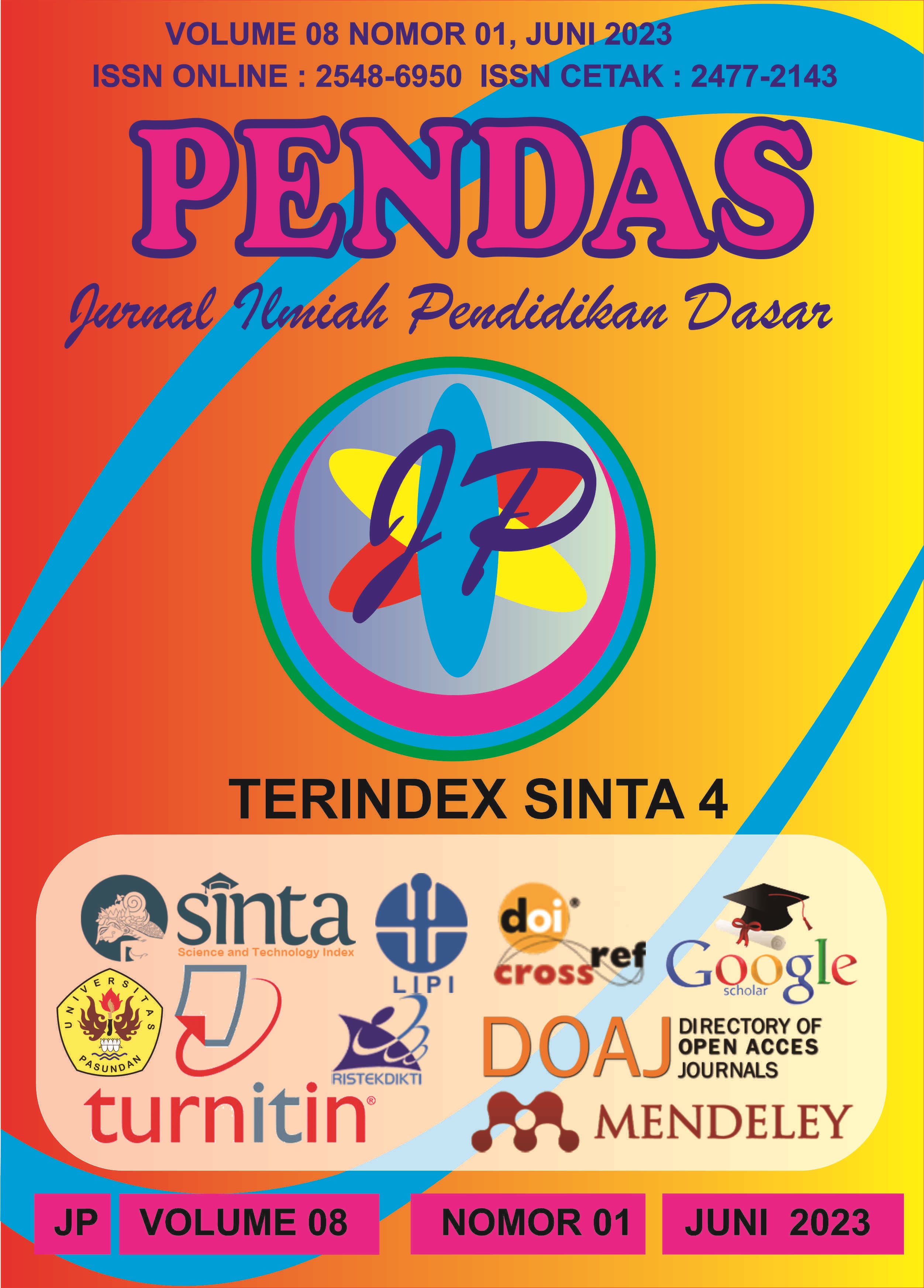PENGARUH KEGIATAN LITERASI DASAR TERHADAP MINAT BACA DAN KETERAMPILAN BERBICARA SISWA KELAS III UPTD SDN PEJAGAN 1 BANGKALAN
DOI:
https://doi.org/10.23969/jp.v8i1.8975Keywords:
Literacy, reading interest, speaking skillAbstract
This study aims to see the effect of basic literacy. Basic literacy is the ability to listen, speak, read, write and do arithmetic. Literacy which includes reading habits is still relatively low, there are some students who are not fluent in reading, the main cause is a feeling of laziness, the consequences of which will all have a bad impact. Students' speaking skills are still not visible, when the learning process students are still not using good and correct language skills. Most students tend to be silent when the teacher asks to speak, if students show speaking skills, students are still stammering, shy and hesitant, reading can improve the use of language properly, so reading and speaking is a very important part of literacy. important in the life of students. Therefore, the school must hold a school literacy program as an effort to encourage students to become more interested in reading in class III UPTD SDN Pejagan 1 Bangkalan. The subjects consisted of 31 grade III students. Data collection techniques used questionnaires and tests. The results showed that in the reliability test of the questionnaire (questionnaire) a value of 0.653 was obtained, then compared with a significant rtable value of 5%, an rtable value of 0.355 was obtained. in conclusion Alpha = 0.653 > rtable = 0.355 and the results obtained in the test item reliability test obtained a value of 0.801 then compared with a significant rtable value of 5% obtained an rtable value of 0.355. Conclusion Alpha = 0.801 > rtable = 0.355. While the results obtained in the Manova test obtained a value of 0.000 <0.05 so it can be concluded that there is an effect of using basic literacy.Downloads
References
Astiningtyas, A., Wardani, N. S., & Prasetyo, T. (2019). Upaya Peningkatan Keterampilan Berbicara Melalui PS-MTTW Dalam Pembelajaran Tematik Terpadu kelas IV SD. Jurnal Basicedu, 3(1), 33–42. https://doi.org/10.31004/basicedu.v3i1.66.
Djollong, A. F. (2014). Tehnik Pelaksanaan Penelitian Kuantitatif (Technique of Quantitative Research). Istiqra’ : Jurnal Pendidikan Dan Pemikiran Islam, 2(1), 86–100. https://jurnal.umpar.ac.id/index.php/istiqra/article/view/224
Elendiana, M. (2020). Upaya Meningkatkan Minat Baca Siswa Sekolah Dasar. Jurnal Pendidikan Dan Konseling (JPDK), 2(1), 54–60. https://doi.org/10.31004/jpdk.v1i2.572
Faradina, N. (2017). Pengaruh Program Gerakan Literasi Sekolah Terhadap Minat Baca Siswa Di Sd Islam Terpadu Muhammadiyah an-Najah Jatinom Klaten. Jurnal Hanata Widya, 6(8), 60–69. http://journal.student.uny.ac.id/ojs/ojs/index.php/fipmp/article/view/9280
Irdawati, Y., & Darmawan. (2014). Meningkatkan Kemampuan Membaca Permulaan Dengan Menggunakan Media Gambar Kelas 1 di Min Buol. Jurnal Kreatif Tadulako Online, 5(4), 1–14.
K.T. Marselina, I.W. Lasmawan, & N. Dantes. (2021). Pengembangan Instrumen Kemampuan Berpikir Kritis Dan Hasil Belajar Ips Pada Siswa Kelas V Sd. Jurnal Penelitian Dan Evaluasi Pendidikan Indonesia, 11(2), 105–114. https://doi.org/10.23887/jpepi.v11i2.620
Mela Fadila Tussani, Ruly Nadian Sari, & Dwi Rohmadi Mustofa. (2020). Hubungan Antara Kebiasaan Literasi Terhadap Keterampilan Berbicara Di Kelas 3 Min 1 Pringsewu. Jurnal Pendidikan Guru Madrasah Ibtidaiyah AL-IBDA’, 1(1), 41–46. https://doi.org/10.54892/jpgmi.v1i1.122
Ningsih. (2021). Hubungan Media Pembelajaran dengan Peningkatan Siswa Pada Mata Pelajaran PAI di SMP Iptek Sengkol Tangerang Selatan. Tarbawai: Jurnal Pendidikan Agama Islam, 6(01), 77–92. https://journal.unismuh.ac.id/index.php/tarbawi/article/view/4452
Nupus, M. H., & Parmiti, D. P. (2017). Peningkatan Keterampilan Berbicara Melalui Penerapan Metode Show and Tell Siswa Sd Negeri 3 Banjar Jawa. Jurnal Ilmiah Sekolah Dasar, 1(4), 296. https://doi.org/10.23887/jisd.v1i4.12289
Nuryadi, Astuti, T. D., Utami, E. S., & Budiantara, M. (2017). Buku ajar dasar-dasar statistik penelitian.
Patiung, D. (2014). Media dan alat Peraga dalam pembelajaran matematika. Bndung:Alfabet. 5(2), 352–376.
Pratama, S. A., & Permatasari, R. I. (2021). Pengaruh Penerapan Standar Operasional Prosedur Dan Kompetensi Terhadap Produktivitas Kerja Karyawan Divisi Ekspor Pt. Dua Kuda Indonesia. Jurnal Ilmiah M-Progress, 11(1), 38–47.
Puspasari, H., & Puspita, W. (2022). Uji Validitas dan Reliabilitas Instrumen Penelitian Tingkat Pengetahuan dan Sikap Mahasiswa terhadap Pemilihan Suplemen Kesehatan dalam Menghadapi Covid-19. Jurnal Kesehatan, 13(1), 65. https://doi.org/10.26630/jk.v13i1.2814
Ruslan & Wibayanti. (2019). Pentingnya Meningkatkan Minat Baca Siswa. Prosiding Seminar Nasional Pendidikan Program Pascasarjana Universitas Pgri Palembang, 767–775. www.perpusnas.go.id
Suriani, A., Chandra, C., Sukma, E., & Habibi, H. (2021). Pengaruh Penggunaan Podcast dan Motivasi Belajar terhadap Keterampilan Berbicara pada Siswa di Sekolah Dasar. Jurnal Basicedu, 5(2), 800–807. https://doi.org/10.31004/basicedu.v5i2.832
Susanti, S., & Purmintasari, Y. D. (2015). PENGARUH PENERAPAN METODE PEMBELAJARAN SQ3R TERHADAP HASIL BELAJAR MAHASISWA PRGRAM STUDI PENDIDIKAN SEJARAH IKIP PGRI PONTIANAK kepribadian. Jurnal Edukasi, 97–104.
Sutisna, I. (2020). Statistika Penelitian: Teknik Analisis Data Penelitian Kuantitatif. Universitas Negeri Gorontalo, 1(1), 1–15. https://repository.ung.ac.id/get/karyailmiah/4610/Teknik-Analisis-Data-Penelitian-Kuantitatif.pdf
Syafitri, N., & Yamin. (2022). Volume 6 Nomor 4 Tahun 2022 Halaman 6218-6223 Research & Learning in Elementary Education https://jbasic.org/index.php/basicedu. Jurnal Basicedu, 6(4), 6218–6223. https://doi.org/10.31004/basicedu.v6i4.3207
Tahmidaten, L., & Krismanto, W. (2020). Permasalahan Budaya Membaca di Indonesia (Studi Pustaka Tentang Problematika & Solusinya). Scholaria: Jurnal Pendidikan Dan Kebudayaan, 10(1), 22–33. https://doi.org/10.24246/j.js.2020.v10.i1.p22-33
Downloads
Published
Issue
Section
License
Copyright (c) 2023 Pendas : Jurnal Ilmiah Pendidikan Dasar

This work is licensed under a Creative Commons Attribution 4.0 International License.



















